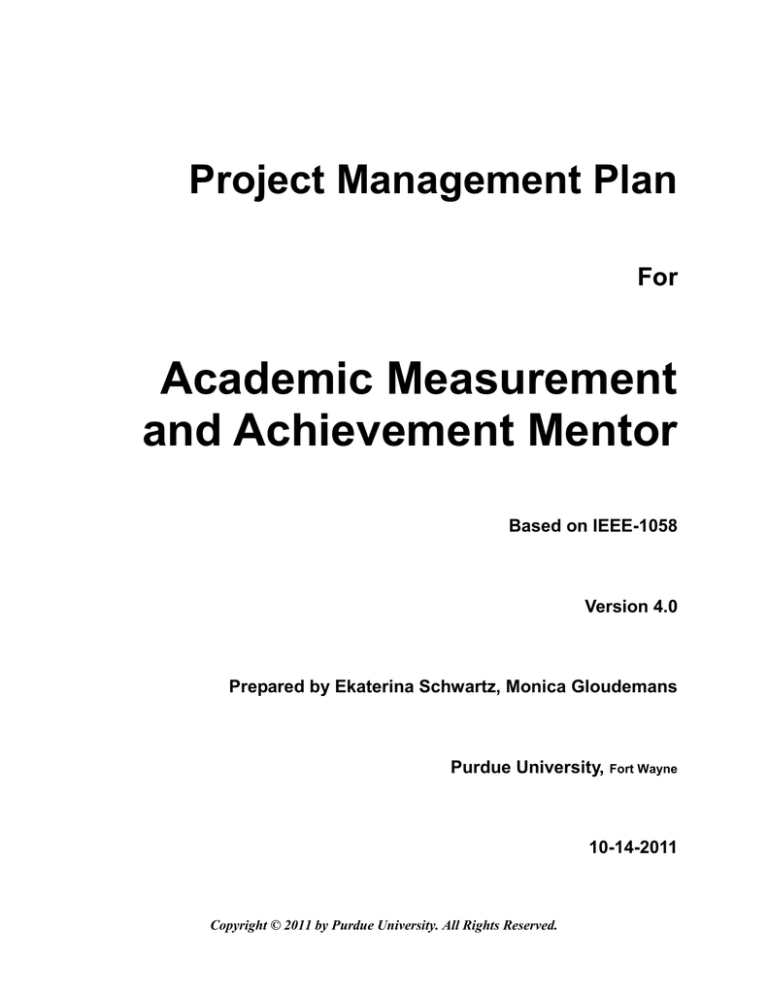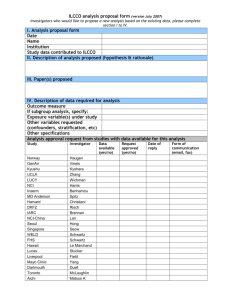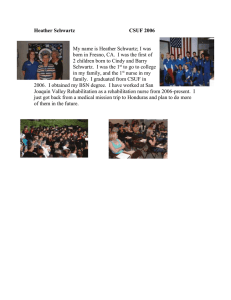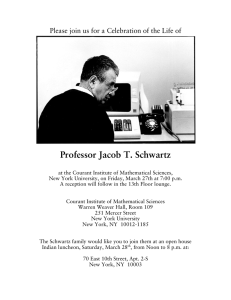Academic Measurement and Achievement Mentor Project Management Plan
advertisement

Project Management Plan For Academic Measurement and Achievement Mentor Based on IEEE-1058 Version 4.0 Prepared by Ekaterina Schwartz, Monica Gloudemans Purdue University, Fort Wayne 10-14-2011 Copyright © 2011 by Purdue University. All Rights Reserved. Project Management Plan for Academic Measurement and Achievement Mentor Copyright © 2011 by Purdue University. All Rights Reserved. Page ii Project Management Plan for Academic Measurement and Achievement Mentor Page iii Table of Contents 1. Overview .................................................................................................................................. 1 1.1. Project Deliverables ......................................................................................................... 3 1.2. Assumptions, Dependencies, and Constraints ................................................................. 4 1.3. References ........................................................................................................................ 4 1.4. Definitions and Acronyms ............................................................................................... 5 1.5. Evolution of the Plan ....................................................................................................... 5 2. Project Organization .............................................................................................................. 5 2.1. Internal Structure ............................................................................................................. 5 2.2. Roles and Responsibilities ............................................................................................... 6 3. Managerial Process Plans....................................................................................................... 6 3.1. Start-Up Plans .................................................................................................................. 6 3.1.1 Estimation Plan .................................................................................................... 6 3.1.2 Staffing Plan......................................................................................................... 6 3.1.3 Staff Training Plan ............................................................................................... 7 3.1.4 Resource Acquisition Plan ................................................................................... 7 3.1.5 Project Commitments........................................................................................... 8 3.2. Work Plan ........................................................................................................................ 8 3.3. Control Plan ................................................................................................................... 10 3.3.1 Data Control Plan ............................................................................................... 10 3.3.2 Requirements Control Plan ................................................................................ 11 3.3.3 Schedule Control Plan........................................................................................ 11 3.3.4 Budget Control Plan ........................................................................................... 11 3.3.5 Communication, Tracking, and Reporting Plan ................................................ 11 3.3.6 Metrics Collection Plan...................................................................................... 11 3.4. Risk Management Plan .................................................................................................. 12 3.5. Issue Resolution Plan ..................................................................................................... 12 3.6. Project Close-Out Plan ................................................................................................... 12 4. Technical Process Plans ........................................................................................................ 12 4.1. Process Model ................................................................................................................ 12 4.2. Methods, Tools, and Techniques ................................................................................... 14 4.3. Configuration Management Plan ................................................................................... 14 4.4. Quality Assurance Plan .................................................................................................. 14 4.5. Documentation Plan ....................................................................................................... 15 4.6. Process Improvement Plan ............................................................................................. 16 Copyright © 2011 by Purdue University. All Rights Reserved. Project Management Plan for Academic Measurement and Achievement Mentor Page 1 1. Overview Elevating expectations for high academic achievement and increasing student-to-teacher ratios make the need for supplemental academic achievement tools evident. The Academic Measurement and Achievement Mentor (AMAM) is a resolution to the lack of timely and iterative assessments of students’ grasp of Indiana state academic standards, the absence of readily available enrichment materials directly linked to specific standards, and the failure to engage parents in the process of the academic standards achievement. The Academic Measurement and Achievement Mentor is geared towards academically proactive parents and their students, as well as any supporters involved with students’ academic endeavors. The goal of the Academic Measurement and Achievement Mentor project is to provide the requirements and analysis, architecture, detail design, project management scoping, and formal documentation for the development of a web-based tool to be used to assist students of various grade levels in mastering State mandated academic standards. The AMAM project is to be developed by implementing practices of the Rational Unified Process. For the purpose of the ACS560 course, the AMAM project is to implement the Inception and Iteration phases of the Rational Unified Process only. Deliverables for this project are to include: Vision Document, Application Architecture, Software Requirements Specification, Design Structure Matrix, Risk Analysis, Class Diagrams, Data Flow Diagrams, Use-Case Diagrams, Sequence Diagrams, and Software Design Description. Table 1 identifies project tasks, schedule and task responsibility. Task Name Start Finish Completed by ACS560 Project Tue 8/23/11 Tue 12/13/11 E Schwartz and M Gloudemans Project Brainstorming Tue 8/23/11 Mon 8/29/11 E Schwartz and M Gloudemans Research Tue 8/23/11 Tue 9/20/11 E Schwartz and M Gloudemans Vision Document Tue 8/30/11 Tue 9/6/11 E Schwartz and M Gloudemans Application Architecture Tue 9/6/11 Tue 9/27/11 v1.0 Tue 9/6/11 Mon 9/12/11 M Gloudemans v2.0 Tue 9/13/11 Mon 9/19/11 E Schwartz and M Gloudemans v3.0 Tue 9/20/11 Mon 9/26/11 M Gloudemans Axiomatic Design Tue 9/13/11 Tue 10/4/11 FR-DP Design Matrix Tue 9/13/11 Tue 9/27/11 E Schwartz DP-DP Dependency Structure Tue 9/20/11 Tue 10/4/11 E Schwartz Matrix Software Requirements Tue 9/13/11 Mon 10/10/11 Specification v1.0 Tue 9/13/11 Mon 9/19/11 M Gloudemans v2.0 Tue 9/20/11 Mon 9/26/11 M Gloudemans v3.0 Mon 10/3/11 Fri 10/7/11 M Gloudemans v4.0 Sun10/23/11 Sun10/23/11 M Gloudemans Risk Analysis FMEA Tue 9/20/11 Mon 10/3/11 E Schwartz Project Management Plan Tue 9/20/11 Tue 10/4/11 v1.0 Tue 9/20/11 Mon 9/26/11 E Schwartz v2.0 Tue 10/10/11 Tue 10/14/11 E Schwartz v3.0 Mon10/24/11 Mon10/24/11 E Schwartz Gantt chart Tue 9/20/11 Mon 10/3/11 Copyright © 2011 by Purdue University. All Rights Reserved. Project Management Plan for Academic Measurement and Achievement Mentor v1.0 v2.0 v3.0 v4.0 Software Design SDD Page 2 Fri 9/23/11 Wed 9/28/11 Sun 10/16/11 Mon10/24/11 Tue 10/4/11 Tue 10/18/11 Fri 9/23/11 M Gloudemans Wed 9/28/11 E Schwartz Sun10/16/11 E Schwartz Mon10/24/11 E Schwartz Tue 12/13/11 Tue 11/29/11 M Gloudemans TBD TBD E Schwartz v1.0 Class Diagrams v1.0 Tue10/18/11 Data Flow Diagram v1.0 v1.0 Activity Diagram v1.0 Sequence Diagram v1.0 State Chart Diagram v1.0 M Gloudemans E Schwartz Tue 10/11/11 Tue 10/25/11 TBD Use Case Diagrams 10/25/11 TBD M Gloudemans E Schwartz Tue 10/11/11 Tue 10/25/11 Tue10/18/11 Thu10/20/11 Tue 10/18/11 Tue 11/1/11 TBD TBD Tue 10/18/11 Tue 11/1/11 TBD TBD M Gloudemans E Schwartz M Gloudemans E Schwartz M Gloudemans E Schwartz Tue 11/1/11 Tue 11/15/11 TBD TBD M Gloudemans E Schwartz Progress Presentation v1.0 Fri 9/23/11 v2.0 Tue10/18/11 v3.0 Fri10/21/11 Project Presentation v1.0 Tue 11/29/11 TBD M Gloudemans E Schwartz M Gloudemans Tue10/18/11 E Schwartz M Gloudemans Tue10/25/11 E Schwartz Tue 12/13/11 M Gloudemans TBD E Schwartz Tue 9/27/11 Table 1 AMAM project tasks, schedule and owner task assignment. The objective of the AMAM project is to provide a model for the development of a webbased academic achievement application. For the purpose of the ACS560 course requirements, the model is to include Inception and Elaboration phase tools of the Rational Unified Process. The objective for the complete AMAM application is to provide timely and iterative assessments and remediation or enrichment materials to be used proactively by students and persons involved in the academic process, with the ultimate result of academic mastery of standards evidenced by improved standardized test scores. Pre-test and post-test studies are to be used to determine the Copyright © 2011 by Purdue University. All Rights Reserved. Project Management Plan for Academic Measurement and Achievement Mentor Page 3 effectiveness of the complete application. In addition, Usability Testing is to be conducted to gauge the user-friendly interface among different age groups. The Academic Measurement and Achievement Mentor is to implement existing assessment and report-generating software, as well as a combination of software, web-links, and instructional videos for enrichment and remediation. Therefore, the research of appropriate material is a vital part of successful completion of the application. The conclusion of unavailability of appropriate software and enrichment material will require the development of such, resulting in resource, deliverables, and schedule revisions. 1.1. Project Deliverables Template or Standard Deliverable Vision Document Application Architecture Software Requirement Specification Design Structure Matrix PMP Delivery Date Delivery Method Comments Sponsor 09-10-2011 Cmap 3-tier architecture Sponsor for web applications IEEE-830 template Sponsor 09-13-2011 Cmap Axiomatic Design Sponsor 10/04/2011 Cmap ACS560 project scope IEEE-1058 template Sponsor 10/07/2011 Cmap Risk Analysis ACS 560 class FMEA standard Design Matrix Axiomatic Design Sponsor 09-27-2011 Cmap Sponsor 10/04/2011 Cmap Gantt Chart ACS 560 class standard IEEE-1016 template UML Sponsor 09-27-2011 Cmap Sponsor TBD Cmap ACS560 project scope ACS560 project scope ACS560 project scope ACS560 project scope ACS560 project scope Sponsor TBD Cmap UML Sponsor TBD Cmap UML Sponsor TBD Cmap UML Sponsor TBD Cmap UML Sponsor TBD Cmap ACS 560 class standard ACS 560 class standard Sponsor 12/13/11 Sponsor 12/13/11 Cmap / presentation In class SDD Class Diagrams Component Diagram Activity Diagrams Sequence Diagrams Use-Case Diagrams Project Presentation Project Binder RUP Recipients 09-27-2011 Cmap Copyright © 2011 by Purdue University. All Rights Reserved. ACS560 project scope ACS560 project scope ACS560 project scope ACS560 project scope ACS560 project scope ACS560 project scope ACS560 project scope ACS560 project scope ACS560 project scope ACS560 project scope Project Management Plan for Academic Measurement and Achievement Mentor Project CD ACS 560 class standard ACS 560 class standards CMAP Sponsor 12/13/11 Sponsor 12/13/11 Page 4 In class ACS560 project scope Publicly posted ACS560 project Gloudemans/Schwartz scope CMAP for ACS560 Table 2 AMAM project deliverables. 1.2. Assumptions, Dependencies, and Constraints The Academic Measurement and Achievement Mentor will be developed based on the following assumptions, dependencies, and constraints: AS-1 Availability of RUP project development tools DE-1 Availability of accurate standards assessment software DE-2 Availability of reporting software DE-3 Availability of current Indiana academic standards for each grade level DE-4 Availability of browser helper plug-ins DE-5 Availability of web browser DE-6 Availability of persistent storage system DE-7 Availability of database systems DE-8 Availability of session management application DE-9 Availability of authorization application DE-10 Availability of authentication application DE-11 Availability of web server DE-12 Availability of web services to provide payment management DE-13Availability of web services to provide accounting services DE-14 Availability of web services to provide content management DE-15Availability of the Internet DE-16 User’s access to computer CO-1 Course duration time constraint CO-2 Extend of owners’ experience and familiarity with project development tools and software 1.3. References Documents and Materials AMAM Vision 1.0 AMAM Application Architecture AMAM SRS-based on IEEE-830 FMEA Gantt Chart IBM Rational Unified Process Access http://cmapspublic.ihmc.us/rid=1JTCCBP9S-F7499N341L/Inception%20Phase.cmap http://cmapspublic.ihmc.us/rid=1JTCCBP9S-F7499N341L/Inception%20Phase.cmap http://cmapspublic.ihmc.us/rid=1JTCCBP9S-F7499N341L/Inception%20Phase.cmap http://cmapspublic.ihmc.us/rid=1JTCCBP9S-F7499N341L/Inception%20Phase.cmap http://cmapspublic.ihmc.us/rid=1JVXFQ725-JCK90K1C58/GanttChartv1_0.pdf http://www.ibm.com/developerworks/rational/library/content/03Jul y/1000/1251/1251_bestpractices_TP026B.pdf AMAM SDD-based on IEEE-1016 Copyright © 2011 by Purdue University. All Rights Reserved. Project Management Plan for Academic Measurement and Achievement Mentor Class Diagrams Component Diagram Activity Diagrams Use-Case Diagrams Sequence Diagram Page 5 TBD TBD TBD TBD TBD Table 3 AMAM references. 1.4. Definitions and Acronyms The following is a list of definitions of acronyms and abbreviations. Acronym Description AMAM Academic Measurement and Achievement Mentor RUP Rational Unified Process SRS Software Requirements Specification FMEA Failure Modes and Effects Analysis DSM Design Structure Matrix FR Functional Requirement DP Design Parameter UML Unified Modeling Language PMP Project Management Plan SDD Software Design Description Table 4 AMAM definitions and acronyms. 1.5. Evolution of the Plan The project management plan is to be updated upon the modification of the SRS, application architecture, FMEA, and changes in the state of dependencies and assumptions. In addition, scheduled weekly review and modification will be conducted as new documentation is introduced and sponsor input is received. 2. Project Organization The Academic Measurement and Achievement Mentor project is developed as part of the ACS560 course work requirement. As an academic project, it does not involve external entities such as customers, subcontractors, purchasing, sales, marketing, legal, finance, procurement, and support individuals or organizations. 2.1. Internal Structure The Academic Measurement and Achievement Mentor is a collaborative project between Monica Gloudemans and Ekaterina Schwartz. Project review and guidance is provided by Dr. Tanik, project’s sponsor. Project work is subdivided among group members by delegating subtasks to each member; however, every output is reviewed and contributed to by each member before submission, thereby making each component of the project a collaborative component. Copyright © 2011 by Purdue University. All Rights Reserved. Project Management Plan for Academic Measurement and Achievement Mentor 2.2. Page 6 Roles and Responsibilities The Academic Measurement and Achievement Mentor is a collaborative project. Project participants include owners Monica Gloudemans and Ekaterina Schwartz, and project sponsor, Dr. Tanik. Project owners are responsible for completing the documentation and analysis following the Rational Unified Process and as specified by the project’s sponsor. Dr. Tanik is responsible for monitoring the project’s progress and providing project input and guidance, as well as evaluating project performance. Students, parents, and students support are not identified as external stakeholders to the project within the scope of the ACS560 course requirement. Such will be required and identified for a complete AMAM project. 3. Managerial Process Plans 3.1. Start-Up Plans 3.1.1 Estimation Plan The AMAM project, within the scope of the ACS560 course work, does not incorporate a cost component. As a result, no cost estimates are conducted. 3.1.2 Staffing Plan The Academic Measurement and Achievement Mentor project, within the scope of the ACS560 course work, is completed through the collaboration of the project’s owners, Monica Gloudemans and Ekaterina Schwartz. The collaboration period spans throughout the duration of the ACS560 course. Minimum skills required of each owner are skills acquired through the successful completion of pre-requisite course work in preparation for the ACS560 course. Dr. Tanik is responsible for monitoring the project’s progress, providing project input and guidance, as well as evaluating project performance. The duration of Dr. Tanik’s involvement with the project spans throughout the duration of the ACS560 course. Dr. Tanik possesses experience as a project sponsor and software engineering instructor, among others. Table 5 identifies task, duration, and assigned owner (s). Task Name Project Brainstorming Research Vision Document Application Architecture v1.0 Application Architecture v2.0 Application Architecture v3.0 FR-DP Design Matrix DP-DP Dependency Structure Matrix SRS v1.0 SRS v2.0 Duration Assigned to 5 days E Schwartz and M Gloudemans 21 days E Schwartz and M Gloudemans 6 days E Schwartz and M Gloudemans 5 days M Gloudemans 5 days E Schwartz and M Gloudemans 5 days M Gloudemans 11 days E Schwartz 11 days E Schwartz 5 days M Gloudemans 5 days M Gloudemans Copyright © 2011 by Purdue University. All Rights Reserved. Project Management Plan for Academic Measurement and Achievement Mentor SRS v3.0 SRS v4.0 Risk Analysis FMEA PMP v1.0 PMP v2.0 PMP v3.0 Gantt chart v1.0 Gantt chart v2.0 Gantt chart v3.0 Gantt chart v4.0 SDD Class Diagrams v1.0 Data Flow Diagram v1.0 Use Case Diagrams v1.0 Activity Diagram v1.0 Sequence Diagram v1.0 State Chart Diagram v1.0 Progress Presentation Project Presentation v1.0 Page 7 5 days M Gloudemans 1 day M Gloudemans 10 days E Schwartz 5 days E Schwartz 6 days E Schwartz 1day E Schwartz 1 day M Gloudemans 1 day E Schwartz 1 day E Schwartz 1day E Schwartz and M Gloudemans 31 days E Schwartz and M Gloudemans 5 days E Schwartz and M Gloudemans 5 days E Schwartz and M Gloudemans 5 days E Schwartz and M Gloudemans 5 days E Schwartz and M Gloudemans 5 days E Schwartz and M Gloudemans 5 days E Schwartz and M Gloudemans 3 days E Schwartz and M Gloudemans 5 days E Schwartz and M Gloudemans Table 5 Tasks, duration, and assigned owner. 3.1.3 Staff Training Plan Training for the completion of project outcomes is provided to project’s owners by Dr. Tanik in the form of lectures on a weekly basis. Additional training is obtained through weekly reading and project research as assigned by Dr. Tanik or individually selected by owners based on their experience. 3.1.4 Resource Acquisition Plan Development resources necessary for the completion of the project within the scope of the ACS560 course requirements are: Computer for each owner Internet connection Microsoft Office Word Microsoft Project Microsoft Visio Microsoft PowerPoint Cmap Tools Acclaro DFSS Document Templates Standards RUP White Paper No acquisition steps for owners’ computer and internet connection are necessary. The Microsoft software resources listed above are acquired through the university’s MSDN Academic Alliance WebStore. Acclaro DFSS is downloaded through the University Licensing System. Templates, standards, and references are provided by project’s sponsor, Dr. Tanik. Copyright © 2011 by Purdue University. All Rights Reserved. Project Management Plan for Academic Measurement and Achievement Mentor Page 8 Product resources include a paper copy and a CD copy of the project’s deliverables. 3.1.5 Project Commitments Table 6 shows project commitments, participants, commitment frequency and a brief explanation. Commitment Made By Weekly sponsor updates Made To Due Date Comments E Schwartz M Gloudemans E Schwartz M Gloudemans Dr. Tanik Weekly Weekly emails with link to updated Cmap Dr. Tanik Weekly Review before Cmap update E Schwartz M Gloudemans M Gloudemans E Schwartz Frequent Timely feedback E Schwartz M Gloudemans M Gloudemans E Schwartz Frequent Complete requested assignments by sponsors deadline Make each other’s work available for review and input before Cmap update Provide timely feedback on work progress Meet sponsor deadlines Table 6 Project Commitments. 3.2. Work Plan Table 7 depicts project phase, activities, outcomes and predecessor tasks. Phase Activities Project Brainstorming Obtain vision document template Complete v1.0 Inception Determine type of application Research architectures of same type Download Microsoft Visio and template Complete v1.0 Revise to v2.0 Revise to v3.0 Determine FRs Determine DPs Enter in Acclaro tool Create FR-DP matrix Outcomes Vision document v1.0 Predecessor tasks Narrow down project topic Preliminary Application Architecture Vision document v1.0 Preliminary FR-DP Matrix Vision document v1.0 Preliminary SRS Application Copyright © 2011 by Purdue University. All Rights Reserved. Project Management Plan for Academic Measurement and Achievement Mentor Enter and Dependencies Create DP-DP matrix Enter DP-DP dependencies Determine external interfaces Determine functions Determine performance requirements Determine logical database requirements Determine design constraints Determine software system attributes Outline change management process Determine potential failures List potential failures in Acclaro tool Determine risk factors Compile completed work for presentation Elaboration Determine Data Flow Create diagram with Microsoft Visio Determine Classes Determine attributes Determine procedures Determine relationships Create diagram with Microsoft Visio List actors List goals List dependencies Create diagram with Microsoft Visio Page 9 Architecture Preliminary DP-DP Dependency Structure Matrix Preliminary FRDP matrix Preliminary Software Requirements Specification Vision document v1.0 Application Architecture Preliminary Risk Analysis FMEA Progress Presentation Data Flow Diagram v1.0 Class Diagrams v1.0 Use Case Diagram v1.0 Copyright © 2011 by Purdue University. All Rights Reserved. Vision Document Application Architecture All work completed to date of presentation Preliminary SRS Preliminary SDD v1.0 Preliminary SRS Preliminary SDD v1.0 Vision document v1.0 Preliminary SRS Application Architecture Preliminary SDD v1.0 Project Management Plan for Academic Measurement and Achievement Mentor Page 10 List step-by step workflow Create diagram with Microsoft Visio Activity Diagram v1.0 Determine process interaction Create diagram with Microsoft Visio Sequence Diagram v1.0 Determine states, events [guards], actions Create diagram with Microsoft Visio State Chart Diagram v1.0 Read standard IEEE1016 Determine design views, attributes, entities, relationships and constraints Implement SDD IEEE standard template Compile current project outputs into presentation Compile project outputs Into presentation slides Preliminary Software Design Description v1.0 Progress Presentation v1.0 Project Presentation v1.0 Vision document v1.0 Preliminary SRS Application Architecture Preliminary SDD v1.0 Vision document v1.0 Preliminary SRS Application Architecture Preliminary SDD v1.0 Vision document v1.0 Preliminary SRS Application Architecture Preliminary SDD v1.0 Vision document v1.0 Application Architecture Preliminary SRS All current project outputs All project outputs Table 7 AMAM Work Plan. 3.3. Control Plan 3.3.1 Data Control Plan Project deliverables are uploaded to project’s Cmap weekly. A copy of each delivered document is stored locally by each project owner. Document templates are provided by project sponsor, Dr. Tanik through University’s Blackboard. Non-deliverable documents such as research papers, additional reading, templates, and project’s Cmap are stored locally by each project owner. Copyright © 2011 by Purdue University. All Rights Reserved. Project Management Plan for Academic Measurement and Achievement Mentor Page 11 3.3.2 Requirements Control Plan Within the scope of the ACS560 course, any changes in the requirements are initiated by project’s owners or project’s sponsor. Such are reflected in a new version of SRS, Acclaro tool files, and the PMP. In addition, the project’s Gantt chart is updated to reflect the changes. 3.3.3 Schedule Control Plan Project’s progress is tracked and monitored with the implementation of a Gantt chart, Microsoft Project. Weekly progress reviews with project’s sponsor provide additional progress measurement and opportunity for suggestions for corrective actions. Gantt chart is modified and workload is distributed among project owners based on sponsor input. 3.3.4 Budget Control Plan The Academic Measurement and Achievement Mentor project, within the scope of the ACS560 course, does not necessitate a budget control plan. 3.3.5 Communication, Tracking, and Reporting Plan Table 8 Communication, tracking, and reporting plan. Type of Communication Communication Schedule Typical Communication Mechanism Who Initiates Recipient Schedule and Effort as needed Tracking Report Status Report Every Tuesday email Project owners Project owners Class meeting Project sponsor Project owners Project Review monthly presentation Project sponsor Requirement Changes as changes are approved email and class meeting Project Review at project completion presentation Project sponsor Project owners Project sponsor Project owners ACS560 class Project owners 3.3.6 Project sponsor Project owners ACS560 class Metrics Collection Plan The project’s Gantt chart contains project tasks and deliverables, baseline start and finish dates, actual start and finish dates, and percentage completed. Such are indicators of performance in terms of meeting requested deadlines and project progress. Project’s Gantt chart is updated weekly after sponsor input is received and tasks are assigned. Project metrics about the content of deliverables are determined and retained by project sponsor, Dr. Tanik. Copyright © 2011 by Purdue University. All Rights Reserved. Project Management Plan for Academic Measurement and Achievement Mentor 3.4. Page 12 Risk Management Plan Failure Mode and Effects Analysis implemented with the Acclaro tool is used to identify, analyze, and prioritize risks associated with the Academic Measurement and Achievement Mentor application. 3.5. Issue Resolution Plan Any problems, issues, and action items that arise during the completion of the project are communicated through email or during class meeting. Any change requirements supplied by the project sponsor are recorded by each owner, and the owner responsible for a revision is assigned. Owner assignment gears towards achieving equal workload and is also based on previous tasks completed. The revised document is emailed between owners for review and input. This process is repeated until all revisions are accepted and a new document version is ready for submission. Changes that do not necessitate a document revision are also divided among project’s owners. The completion of change requests is followed up with informative emails among project owners. Decision making between project owners is dynamic and based on the particular issue at hand. Factors for determining the decision maker for a particular issue are owner’s experience and research in the area of discussion. 3.6. Project Close-Out Plan The close-out of the Academic Measurement and Achievement Mentor project, within the scope of the ACS560 course, consists of a project presentation and compilation of project binder and project copy CD. The presentation is conducted by both owners and includes the latest version of each project outcome. 4. Technical Process Plans 4.1. Process Model The Academic Measurement and Achievement Mentor is developed following the Rational Unified Process (RUP). The Rational Unified Process provides guidelines, templates and tool mentors for the following best practices: 1. Develop software iteratively 2. Manage requirements 3. Use component-based architectures 4. Visually model software 5. Verify software quality 6. Control changes to software RUP is described in two dimensions: Horizontal axis- representing the time and dynamic aspect of the process, expressed in terms of cycles, phases, iterations, and milestones Vertical axis- representing the static aspect of the process, in terms of activities, artifacts, worker and workflows RUP divides one development cycle in four consecutive phases as follows: Inception phase Elaboration phase Copyright © 2011 by Purdue University. All Rights Reserved. Project Management Plan for Academic Measurement and Achievement Mentor Page 13 Construction phase Transition phase Each phase is concluded with a milestone. The outcome of RUPs inception phase is: A vision document: a general vision of the core project’s requirements, key features, and main constraints. An initial use-case model An initial business case An initial risk assessment A project plan A business model One or several prototypes Evaluation criteria for the inception phase are: Stakeholder concurrence on scope definition and cost/schedule estimates. Requirements understanding as evidenced by the fidelity of the primary use cases. Credibility of the cost/schedule estimates, priorities, risks, and development process. Depth and breadth of any architectural prototype that was developed. Actual expenditures versus planned expenditures. The outcome of RUPs elaboration phase is: A use-case model. Supplementary requirements capturing the non functional requirements and any requirements that are not associated with specific use-case. A software architecture description. An executable architectural prototype. A revised risk list and a revised business case. A development plan for the overall project. An update development case specifying the process to be used. A preliminary user manual Evaluation criteria for the elaboration phase are: Is the vision of the product stable? Is the architecture stable? Does the executable demonstration show that the major risk elements have been addressed and credibly resolved? Is the plan for the construction phase sufficiently detailed and accurate? Is it backed up with a credible basis of estimates? Do all stakeholders agree that the current vision can be achieved if the current plan is executed to develop the complete system, in the context of the current architecture? Is the actual resource expenditure versus planned expenditure acceptable? The construction and transition phases of the Rational Unified Process are not applied to this project within the scope of the ACS560 course work, and their discussion will therefore be omitted. Not every outcome of RUP’s inception and elaboration phases is developed for this project due to the time constraint of the course. Copyright © 2011 by Purdue University. All Rights Reserved. Project Management Plan for Academic Measurement and Achievement Mentor 4.2. Page 14 Methods, Tools, and Techniques The outcomes of the inception and elaboration phases of the Academic Measurement and Achievement Mentor project are produced on standard PCs with Operating Systems compatible with the following software: Microsoft Office Word- Vision document, SRS, top-level FR-DPs, SDD Microsoft Project- Gantt chart Microsoft Visio- Data Flow diagram, Use-Case diagram, Activity diagram, Sequence diagram, State chart, Application Architecture Microsoft PowerPoint- Progress presentation, Close-out presentation Cmap Tools- Storage and management of project outcomes Acclaro DFSS- FMEA, DSM The following standards, languages, theories, and templates are implemented within the project: The Axiomatic Design Theory-mapping of functional requirements and design parameters IEEE Recommended Practice for Software Requirements-SRS SRS Software Requirement template- adapted from the IEEE Guide to Software Requirements Specifications (Std 830-1993) SDD Software Design Description template- (Std 1016-2009) Three-Tier web-based application approach- Application Architecture RUP Vision document template- Vision document UML- Data flow diagram, use-case diagram, activity diagram, sequence diagram, state chart diagram Quality assurance practices are not developed within the scope of the ACS560 course work. 4.3. Configuration Management Plan Baselines are established by project’s sponsor. Any changes requested by the project sponsor are recorded by each owner, and the owner responsible for completing changes is assigned. The completion of changes is followed up with informative emails among project owners. 4.4. Quality Assurance Plan To assure project quality, each of the project’s outcomes is reviewed and contributed to by both project owners. Further, project sponsor is notified by email with link to project’s Cmap for review and input. Progress presentation provides additional peer review and input to project’s deliverables. Copyright © 2011 by Purdue University. All Rights Reserved. Project Management Plan for Academic Measurement and Achievement Mentor 4.5. Page 15 Documentation Plan Template or Standard Document Vision document RUP Application Architecture FR-DP Design Matrix 3-tier webbased pattern Axiomatic Design Axiomatic Design IEEE-830 template IEEE-1016 template IEEE-1058 template DP-DP Dependency Structure Matrix SRS SDD PMP Gantt Chart N/A Class Diagrams UML Component Diagram UML Use-case Diagrams UML Activity Diagram UML Sequence Diagram UML Progress Presentation N/A Project Binder Class Standard Project CD Class Standard Project CMAP Class Standard Project Presentation N/A Created By Reviewed By Target Date Distribution M Gloudemans Dr. Tanik E Schwartz M Gloudemans Dr. Tanik 09/26/2011 Cmap 9/26/2011 Cmap E Schwartz Dr. Tanik 9/27/2011 Cmap E Schwartz Dr. Tanik 10/04/2011 Cmap M Gloudemans Dr. Tanik 10/7/2011 Cmap M Gloudemans E Schwartz M Gloudemans E Schwartz M Gloudemans E Schwartz M Gloudemans E Schwartz M Gloudemans E Schwartz M Gloudemans E Schwartz M Gloudemans E Schwartz M Gloudemans E Schwartz M Gloudemans E Schwartz M Gloudemans E Schwartz M Gloudemans E Schwartz M Gloudemans E Schwartz M Gloudemans E Schwartz Dr. Tanik 11/29/2011 Cmap Dr. Tanik 10/7/2011 Cmap Dr. Tanik 9/28/2011 Cmap Dr. Tanik 11/01/11 Cmap Dr. Tanik 11/08/11 Cmap Dr. Tanik 11/01/2011 Cmap Dr. Tanik 11/15/2011 Cmap Dr. Tanik 11/15/2011 Cmap Dr. Tanik 9/27/2011 Cmap Dr. Tanik 12/13/2011 In class Dr. Tanik 12/13/2011 In class Dr. Tanik Weekly updates Cmap Dr. Tanik 12/13/2011 Cmap Table 9 AMAM Document plan. Copyright © 2011 by Purdue University. All Rights Reserved. Project Management Plan for Academic Measurement and Achievement Mentor 4.6. Page 16 Process Improvement Plan A Process Improvement Plan is not developed for Academic Measurement and Achievement Mentor within the scope of the ACS560 course. Copyright © 2011 by Purdue University. All Rights Reserved. Project Management Plan for Academic Measurement and Achievement Mentor Page 17 Revision History Name Ekaterina Schwartz Monica Gloudemans Ekaterina Schwartz Monica Gloudemans Ekaterina Schwartz Monica Gloudemans Ekaterina Schwartz Monica Gloudemans Date Reason for Changes 09/22/11 To complete document’s Overview and Project Organization sections. 1.0 10/14/11 To complete document’s Managerial Process Plans and Technical Process Plans sections 2.0 10/24/11 To implement sponsor’s input and to update tables 1, 2, 3, 5, 7, 9 3.0 11/09/11 To update deliverables chart 4.0 Copyright © 2011 by Purdue University. All Rights Reserved. Version




